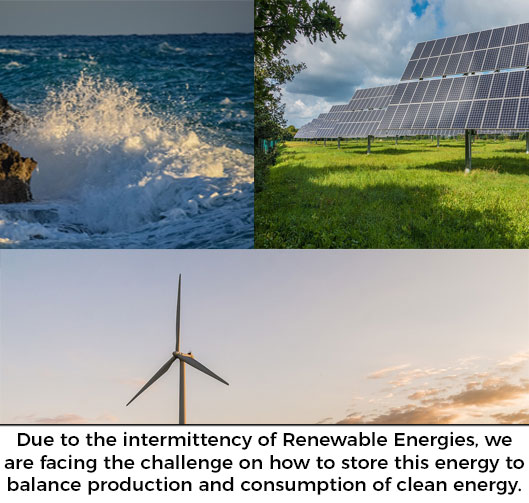You need then to reach -253°C, the temperature at which hydrogen become liquid to store it this way.
This technology is very enervy intensive and, so has not catched our attention.
Hydrogen is here absorbed in a material, a hydride, in a reversible way, which means that hydrogen is being restored or “desorbed” when it should be used. The disadvantage of this technology is the limited mass absorption capacity of these materials. The final weight of the storage system is therefore important. It is for this reason that those tanks are mainly used for stationary applications or for small mobile and nomadic applications. There are numerous hydrides’ families, the ones we developed run at room temperature and low pressure and ensure therefore inherent safety.
To reduce the storage volume of a gas, we have to increase its pressure. MAHYTEC develops for example tanks at medium pressure (30bar, i.e. 30 times the atmospheric pressure but controls also the high pressure, 700bar. The manufacturing process is based on the technology of filament winding. We reinforce a plastic liner which contains the hydrogen in its gaseous form by composite materials fibers (carbon fiber mainly). These fibers will on their side allow the liner to withstand more significant loads, and particularly a higher pressure.
The share of renewable energies in the global energy mix is set to increase. The intermittence of their production requires attention to their storage, in order to smooth the power generation capacity with the electricity needs of consumers. Indeed, solar panels or wind turbines, for example, often produce electricity when consumers need it the least. On the other hand, at the end of the day or in winter, the production capacities are often insufficient to meet the needs and peaks of consumption.
There are battery technologies that have already proven their capacity for short-term storage, including every day. However for storage where the need for autonomy is important, or where the surplus energy to store is substantial, hydrogen makes sense.
Part of the excess of renewable energies is transformed into hydrogen via an electrolyser, then stored to be redistributed when the consumption is too important and can not be assured only by the renewable energies.
Read our comic for more information or consult the website of the AFHYPAC (French Association of Hydrogen and Fuel Cells) or the hydrogen blog of the region Bourgogne Franche-Comté, ENERGY Flash



1 kg of oil = 12kWh of energy
1kg of hydrogen= 33Kwh of energy.
If you want to make electricity from hydrogen, you can use a fuel cell (PAC). The productivity of a PAC are currently 50%.
1kg d’H2= 16,5kWh electric + 16.5Kwh (heat)
Hydrogen being a very light gas, it is necessary to compress it to reduce the storage volume.
On this link we can see the density (mol/l)/ pressure (MPa) curve of hydrogen. Since hydrogen is not a perfect gas, we do not observe a straight line.
This curve makes it possible to know the mass of hydrogen stored for a given volume as a function of the pressure applied to it.
Example :
A 50L hydrogen tank will store at 15 ° C approximately :
– at 100bar (10MPa) : 50 (volume in L) x 2* (g/mol) x 3,9340 (mol/L) = 393,40g
– at 350bar (35MPa) : 50 x 2 x 11,908 = 1190,8g
– at 700bar (70MPa) : 50 x 2 x 19,935 = 1993,5g
*It takes about 2 g/mol